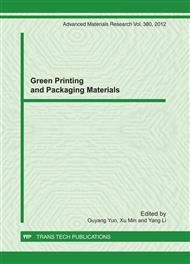p.205
p.209
p.213
p.218
p.222
p.226
p.230
p.234
p.238
Study on Chitosan Food Preservatives Technology
Abstract:
With the improvement of living standards, the requirement of food quality, nutrition, and freshness have been higher and higher. As the characteristics of highly effective, non-toxic, low cost, easy operation and significantly preservation effect, chitosan has been used widely as a new type of natural antistaling agent. Chitosan fresh-keeping mechanism and application in food preservatives are discussed in this study. From the three aspects of chitosan coating, composite coating, and chitosan modification, this work provides an overview of some researches about chitosan fresh food technology in abroad and domestic. And further development is discussed: the effect of the sole use of chitosan is not very good. Composite coating of chitosan will be more and more attractive with the merits about effectively preventing moisture loss, reducing weightlessness rate and so on. Storage stability about liquid chitosan can be solved by modified chitosan, which will also have a more attractive effect. This paper has theoretical significance to develop chitosan applications in food fresh-keeping technology.
Info:
Periodical:
Pages:
222-225
Citation:
Online since:
November 2011
Authors:
Price:
Сopyright:
© 2012 Trans Tech Publications Ltd. All Rights Reserved
Share:
Citation:


